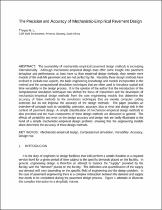JavaScript is disabled for your browser. Some features of this site may not work without it.
- ResearchSpace
- →
- Research Publications/Outputs
- →
- Conference Publications
- →
- View Item
| dc.contributor.author |
Theyse, HL

|
|
| dc.date.accessioned | 2007-08-27T09:25:02Z | |
| dc.date.available | 2007-08-27T09:25:02Z | |
| dc.date.issued | 2006-09 | |
| dc.identifier.citation | Theyse, HL. 2006. Precision and accuracy of mechanistic-empirical pavement design. 10th International conference on Asphalt Pavements, Canada, Quebec City, 12-17 August, 2006, pp 12 | en |
| dc.identifier.uri | http://hdl.handle.net/10204/1176 | |
| dc.description | 2006 10th International conference on Asphalt Pavements | en |
| dc.description.abstract | The availability of mechanistic-empirical pavement design methods is increasing internationally. Although mechanistic-empirical design does offer some insight into pavement behaviour and performance, at least more so than empirical design methods, they remain mere models of the real-life pavement and are not perfect by far. Recently these design methods have evolved to include two aspects, the basic engineering knowledge and models incorporated in the method and the computational simulation techniques that are often used to introduce spatial and time variability in the design process. It is the opinion of the author that the introduction of the computational simulation techniques has shifted the focus of researchers and the developers of mechanistic-empirical design methods from the core engineering models that determine the accuracy of these methods to the simulation techniques that are merely computer coding exercises but do not improve the accuracy of the design methods. The paper provides an overview of concepts such as variability, precision, accuracy, bias or error and design risk in the context of pavement design. A simple classification of mechanistic-empirical design methods is also provided and the main components of these design methods are discussed in general. The effects of variability and error on the design accuracy and design risk are lastly illustrated at the hand of a simple mechanistic-empirical design problem, showing that the engineering models alone determine the accuracy of these design methods | en |
| dc.language.iso | en | en |
| dc.subject | Mechanistic empirical design | en |
| dc.subject | Computational simulation | en |
| dc.subject | Design risk | en |
| dc.subject | Pavement designs | en |
| dc.subject | 10th International conference on Asphalt Pavements, 12-17 August, 2006 | en |
| dc.title | Precision and accuracy of mechanistic-empirical pavement design | en |
| dc.type | Conference Presentation | en |
| dc.identifier.apacitation | Theyse, H. (2006). Precision and accuracy of mechanistic-empirical pavement design. http://hdl.handle.net/10204/1176 | en_ZA |
| dc.identifier.chicagocitation | Theyse, HL. "Precision and accuracy of mechanistic-empirical pavement design." (2006): http://hdl.handle.net/10204/1176 | en_ZA |
| dc.identifier.vancouvercitation | Theyse H, Precision and accuracy of mechanistic-empirical pavement design; 2006. http://hdl.handle.net/10204/1176 . | en_ZA |
| dc.identifier.ris | TY - Conference Presentation AU - Theyse, HL AB - The availability of mechanistic-empirical pavement design methods is increasing internationally. Although mechanistic-empirical design does offer some insight into pavement behaviour and performance, at least more so than empirical design methods, they remain mere models of the real-life pavement and are not perfect by far. Recently these design methods have evolved to include two aspects, the basic engineering knowledge and models incorporated in the method and the computational simulation techniques that are often used to introduce spatial and time variability in the design process. It is the opinion of the author that the introduction of the computational simulation techniques has shifted the focus of researchers and the developers of mechanistic-empirical design methods from the core engineering models that determine the accuracy of these methods to the simulation techniques that are merely computer coding exercises but do not improve the accuracy of the design methods. The paper provides an overview of concepts such as variability, precision, accuracy, bias or error and design risk in the context of pavement design. A simple classification of mechanistic-empirical design methods is also provided and the main components of these design methods are discussed in general. The effects of variability and error on the design accuracy and design risk are lastly illustrated at the hand of a simple mechanistic-empirical design problem, showing that the engineering models alone determine the accuracy of these design methods DA - 2006-09 DB - ResearchSpace DP - CSIR KW - Mechanistic empirical design KW - Computational simulation KW - Design risk KW - Pavement designs KW - 10th International conference on Asphalt Pavements, 12-17 August, 2006 LK - https://researchspace.csir.co.za PY - 2006 T1 - Precision and accuracy of mechanistic-empirical pavement design TI - Precision and accuracy of mechanistic-empirical pavement design UR - http://hdl.handle.net/10204/1176 ER - | en_ZA |






